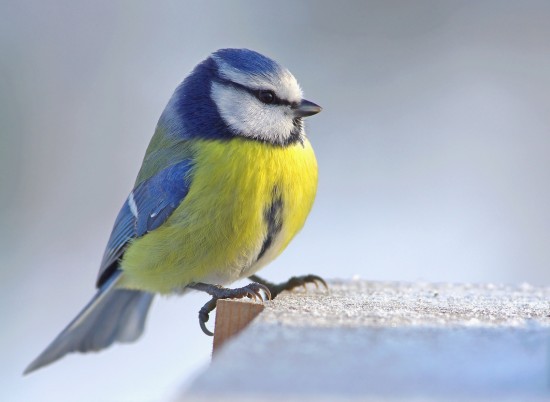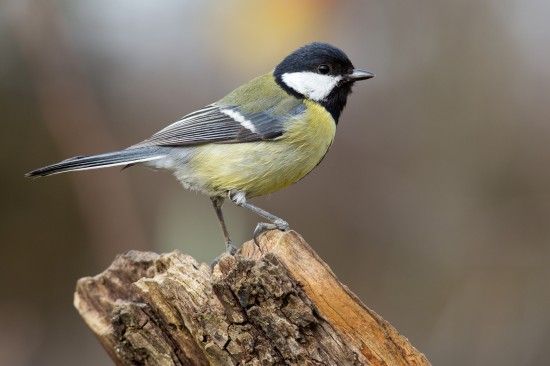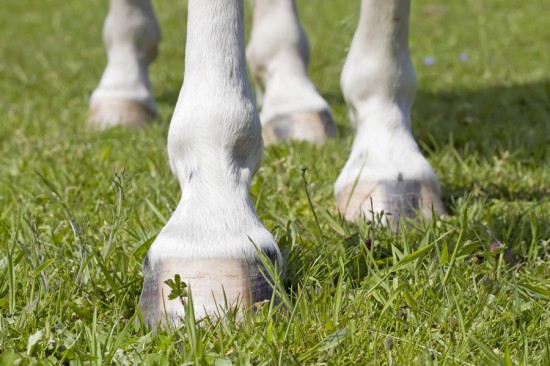



The little birds known as Tits are among some of the most recognisable of the garden birds we see across the UK. Famous little faces such as the Blue Tit and the Great Tit are easily spotted with their bright blue and green feathers dodging up to bird feeders and running off with the contents. But did you know where they like to nest? Their favourite food? How many chicks they have? Here are a few insights into the life of a Tit.
The Eurasian Blue Tit (Cyanistes caeruleus) is probably the most recognisable of the family. These little birds are resident in the UK so they don’t migrate in the winter and can be seen visiting the gardens all year round. They are around 12cm in length with a wingspan of 18cm and weigh around 11 grams.
The typical Blue Tit has an azure blue crown and a dark blue line that passes through the eye and circling around the white cheeks to the chin. The forehead is white as well as the bar on the wings and the nape, tail and wings are blue with the back being yellow-green. Underparts are a sulphur-yellow and there is a dark line down the abdomen – the yellowness of these feathers is dictated by the amount of caterpillars the birds have consumed.
Figures estimate there are 20-44 million pairs across Europe and are found across the continent as well as in parts of the Middle East. They often live in mixed winter flocks with Great Tits.
Blue Tits will make use of a hole in a tree, a wall or a stump to make their nest as well as using artificial nest boxes if sited correctly. They return to the same spot each year if they have been successful and are amongst the easiest to accept artificial nesting spots. When they are on the nest, they can be aggressive protectors of eggs and chicks with crests raised and issuing a hissing noise to ward away intruders.
The nest is lined with moss, wool, feathers and hairs and the eggs are laid in April or May. They have very large clutches with seven to eight being average but larger being frequently seen. The parents are prodigious feeders of their large brood with a single bird feeding chicks at a rate of one feed every 90 seconds at the height of the season.
As well as making use of offerings at the bird table, Blue Tits are great for getting rid of pests and are top on the list of birds that eat aphids and other plant destroyers. They will have a few young tree buds added to their diet but otherwise are largely beneficial to the garden. They are also partial to leaf miner grubs as well as those of some moths.
Blue Tits are a species that exhibit what is called cultural learning. Going back to the 1920s, it was noticed they had learned to open milk bottle tops to get at the cream underneath and this behaviour was passed amongst the birds. Unfortunately, with the advent of plastic bottles, this inventive behaviour is no longer seen.
The Great Tit (Parus major) is a common bird across Europe, the Middle East, Central and northern Asia and areas of North Africa. As its name indicates, it is one of the largest of the tit family at 12.5-14cm in length and is a distinctive bird. It has a bluish black crown, black neck, throat, head, and white cheeks. The breast is lemon yellow and has a broad black stripe down the centre. The back if olive green and the wings are bluish grey. Females are similar but slightly less intense in the colouring.
Great Tits are found in a variety of habitats, most commonly in deciduous woodlands, mixed forest and around the edges of forests. It generally doesn’t migrate apart from in the extreme northern parts of its range.
These birds are mainly insectivores and feed on insects and spiders caught in amongst the foliage. They are beneficial in orchards as they catch a lot of caterpillars for their young, removing a potential pest. Outside breeding season, they will add seeds and berries to their diet from the trees and shrubs around them.
Great Tits form monogamous pairs and have a distinct territory that is established in late January and retaken each year. They breed in cavities such as a tree or in a wall or rock face but will also use nesting boxes. Commonly laid clutches are between 5-12 eggs but as many as 18 have been recorded and this is because they suffer a high chick mortality rate due to predation.
Great Tits are keen garden visitors and are great to watch due to their acrobatic nature and ease of adapting to artificial structures for nesting. One example is the city of Sheffield has around half a million human inhabitants and around 17,000 Great Tits!
The Coal Tit (Periparus ater) may be the lesser known of the three species but may be a more common garden visitor than people realise. They are duller I colour than the Great Tit, smaller and have a white patch on the back of their head that makes them easier identifiable from the right angle.
These little birds are around 10-11cm in length and head, throat and neck feathers are blue black with off-white cheeks. Underparts of whitish and the bill and legs are black.
Their natural environment is the temperate conifer forest but will easily adapt to other habitats. They are found across Europe and Asia and only migrate in the coldest parts of their range. They are often seen with other tits and is active when visiting the garden as its cousins, often plundering the feeder then perching nearby to eat its haul.
They will nest in a tree stump, own low down, or in holes in the ground include mice and rabbits burrows, between stones in walls or using other birds abandoned nests or squirrel dreys. Between seven and eleven eggs are laid commonly in May and they produce only one clutch each year.
 A Feeding Guide For Weimaraners
A Feeding Guide F
A Feeding Guide For Weimaraners
A Feeding Guide F
 Common Conditions Of The Equine Foot
Common Conditions
Common Conditions Of The Equine Foot
Common Conditions
 Doggy Day Care - Options For Your Dog If You Work All Day
Doggy Day Care -
Doggy Day Care - Options For Your Dog If You Work All Day
Doggy Day Care -
 More Tips On Being A Responsible Dog Breeder
More Tips On Bein
More Tips On Being A Responsible Dog Breeder
More Tips On Bein
 Ten Ways In Which Canine Diet May Affect Behaviour
Ten Ways In Which
Ten Ways In Which Canine Diet May Affect Behaviour
Ten Ways In Which
Copyright © 2005-2016 Pet Information All Rights Reserved
Contact us: www162date@outlook.com